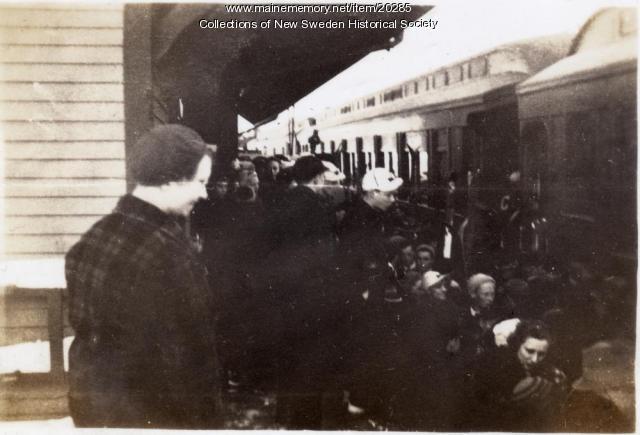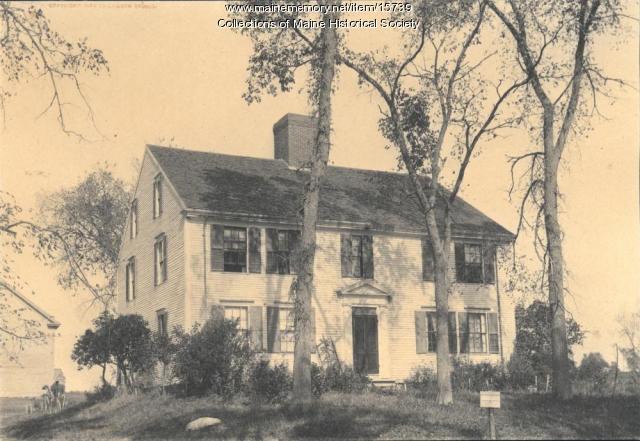Keywords: arrivals
Item 26859
New CCC arrivals, Bridgton, 1935
Contributed by: Maine Forest Service Date: 1935 Location: Bridgton Media: Photographic print
Item 20285
Winter Carnival arrivals, New Sweden, 1936
Contributed by: New Sweden Historical Society Date: 1936 Location: New Sweden Media: Photographic print
Item 151738
Home for aged women, Portland, 1900-1926
Contributed by: Maine Historical Society Date: 1900–1926 Location: Portland Client: unknown Architect: John Calvin Stevens and John Howard Stevens Architects
Item 151728
Sewall camp additions, Phippsburg, 1914
Contributed by: Maine Historical Society Date: 1914 Location: Phippsburg Client: Harold M. Sewall Architect: John Calvin Stevens and John Howard Stevens Architects
Exhibit
The astronomical arrival of winter -- also known as the winter solstice -- marks the year's shortest day and the season of snow and cold. It usually arrives on December 21.
Exhibit
Following his historic flight across the Atlantic in May 1927, aviator Charles Lindbergh commenced a tour across America, greeted by cheering crowds at every stop. He was a day late for his speaking engagement in Portland, due to foggy conditions. Elise Fellows White wrote in her diary about seeing Lindbergh and his plane.
Site Page
Mount Desert Island: Shaped by Nature - More Permanent Settlers Arrive
"More Permanent Settlers Arrive Two major waves of settlers arrived after 1768 – the first from Gloucester, Massachusetts in addition to James…"
Site Page
Mount Desert Island: Shaped by Nature - Arriving in Bar Harbor
"Arriving in Bar Harbor Bar Harbor steamboat landing, ca. 1885Maine Historic Preservation Commission Arriving at the Bar Harbor wharf…"
Story
From France to Farmington
by Celine Couillaut
I arrived in Maine and never left.
Story
Ronald Ramsay - MLTI impact in Washington County's MSAD 37
by MLTI Stories of Impact Project
Ronald Ramsay describes the impact of the arrival of on-to-one laptops in MSAD 37.
Lesson Plan
Longfellow Studies: The Elms - Stephen Longfellow's Gorham Farm
Grade Level: 6-8, 9-12
Content Area: English Language Arts, Social Studies
On April 3, 1761 Stephen Longfellow II signed the deed for the first 100 acre purchase of land that he would own in Gorham, Maine. His son Stephen III (Judge Longfellow) would build a home on that property which still stands to this day. Judge Longfellow would become one of the most prominent citizens in Gorhams history and one of the earliest influences on his grandson Henry Wadsworth Longfellow's work as a poet.
This exhibit examines why the Longfellows arrived in Gorham, Judge Longfellow's role in the history of the town, Henry Wadsworth Longfellow's vacations in the country which may have influenced his greatest work, and the remains of the Longfellow estate still standing in Gorham today.
Lesson Plan
Grade Level: 3-5, 6-8, 9-12
Content Area: Science & Engineering, Social Studies
This lesson plan will give middle and high school students a broad overview of the ash tree population in North America, the Emerald Ash Borer (EAB) threatening it, and the importance of the ash tree to the Wabanaki people in Maine. Students will look at Wabanaki oral histories as well as the geological/glacial beginnings of the region we now know as Maine for a general understanding of how the ash tree came to be a significant part of Wabanaki cultural history and environmental history in Maine. Students will compare national measures to combat the EAB to the Wabanaki-led Ash Task Force’s approaches in Maine, will discuss the benefits and challenges of biological control of invasive species, the concept of climigration, the concepts of Traditional Ecological Knowledge (TEK) and Indigenous Knowledge (IK) and how research scientists arrive at best practices for aiding the environment.
















